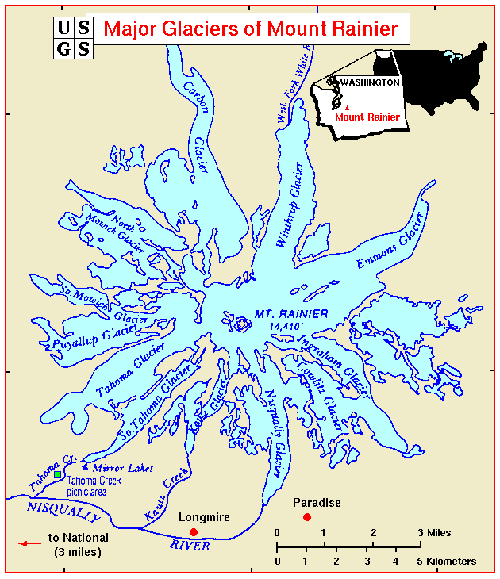Glacial Outburst Floods
Floods
Glacial Outburst Floods
- What is a glacial outburst flood?
- A glacial outburst flood is a hydrological phenomenon that refers to the sudden release of water stored in glaciers. At Mount Rainier, these floods are a serious threat to the river valleys and could create flooding greater than an extreme meteorological flood such as a 100-year flood (Hoblitt and others, 1995:6). Therefore, it is quite apparent that glacial outburst flooding is one of the greatest hazards associated with Mount Rainier. In fact, the large volume of water stored in Rainier’s glaciers is partially responsible for its inclusion in the decade studies.

- Glacial outburst flooding at Mount Rainier?
- Mount Rainier is famous for the phenomenal amount of water it holds in the form of ice and snow. In all, it has 26 named glaciers residing on its summit and slopes. Hydrologists from the CVO have calculated that there are 36 square miles of perennial ice and snow on Rainier. This is more than on all the other Cascade volcanoes combined (Krakauer, 1996:34) and more than any other mountain in the conterminous United States (Hoblitt and others, 1995:1). In other words - that’s a whole lot of ice!
- What would cause these glaciers to melt?
- Certainly the warming of Mount Rainier due to increased magma injection and, more dramatically, lava flow onto the glaciers could cause immense flooding. Also, there is a chance that the hydrothermal circulation within Rainier could change due to the formation of new faults and fractures and would thus bring superheated liquid into contact with existing ice and snow (U.S. Geodynamics Committee, 1994:30). This is not an unknown phenomenon and has occurred at other Cascade volcanoes - most recently at Mount Baker in 1975 (U.S. Geodynamics Committee, 1994:30). However, the majority of past glacial floods have occurred in the absence of volcanic processes. The best studied outburst floods at Mount Rainier have been correlated to periods of unusually high temperature and increased rain in the non-winter months (Hoblitt and others, 1995:6). All of the above possibilities of flooding are, unfortunately, extremely difficult to predict.
Click Here - Learning From Experience Glacial Outburst Floods
Next:
Continue with Lahars